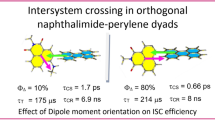Abstract
A series of molecules containing a naphthalene chromophore and a stable free radical 2,2,6,6-tetramethylpiperidine-1-oxyl (TEMPO) covalently linked by a spacer group of different lengths have been synthesized. In n-hexane solution, their photophysical behavior was studied and compared with a system of freely moving naphthalene and the free radical TEMPO. The linked molecules showed strong quenching of the singlet and triplet states of the naphthalene moiety, compared to when naphthalene and TEMPO were not linked. The quenching efficiency decreased with increasing the length of the spacer group. In addition, new electronic absorption and emission bands, along with the usual bands of the individual moieties, were also seen. These news bands have been attributed to the formation of electron donor-acceptor charge-transfer complexes in the ground state, arising from the interaction between the two moieties in close proximity. The photophysical dynamics of the linked molecules has been rationalized by assuming the existence of two types of population of the linked molecules: folded and extended. The ground state complex formation is proposed to occur only in the folded conformation of the linked molecules. To our knowledge, this is possibly the first example of a ground state charge-transfer complex formation involving a TEMPO free radical and naphthalene.










Similar content being viewed by others
References
Bowen EJ, Metcalf WS (1951) The quenching of anthracene fluorescence. Proc R Soc London A 206:437–447
Reynolds EW, Demas JN, DeGraff BA (2013) Viscosity and temperature effects on the rate of oxygen quenching of Tris-(2,2′-bipyridine) ruthenium(II). J Fluoresc 23:237–241
Ware WR (1962) Oxygen quenching of fluorescence in solution: an experimental study of the diffusion process. J Phys Chem 66:455–458
Gijzeman OL, Kaufman F, Porter GJ (1973) Oxygen quenching of aromatic triplet states in solution 1. J Chem Soc Faraday Trans 2(69):708–720
Watkins AR (1974) Quenching of electronically excited states by the free radical tetramethyl piperidine nitroxide. Chem Phys Lett 29:526–528
Mintu P, Jockusch J, Ottaviani MF, Turro NJ, Ramamurthy V (2011) Interaction between encapsulated excited organic molecules and free nitroxides: communication across a molecular wall. Langmuir 27:10548–10555
Kuzmin VA, Tatikolov AS (1977) Formation of triplets of aromatic hydrocarbons on quenching of excited singlet states by nitroxyl radicals. Chem Phys Lett 51:45–47
Green SA, Simpson DJ, Zhou G, Ho PS, Blough NV (1990) Intramolecular quenching of excited singlet states by stable nitroxyl radicals. J Am Chem Soc 112:7337–7346
Gijzeman OL, Kaufman F, Porter G (1973) Quenching of aromatic triplet states in solution by nitric oxide and other free radicals. J Chem Soc Faraday Trans 2(69):727–737
Aliagaa C, Fuentealba P, Rezendea MC, Cárdenasb C (2014) Mechanism of fluorophore quenching in a pre-fluorescent nitroxide probe: a theoretical illustration. Chem Phys Lett 593:89–92
Kawai A, Okutsu T, Obi K (1991) Spin polarization generated in the triplet-doublet interaction: hyperfine-dependent chemically induced dynamic electron polarization. J Phys Chem 95:9130–9134
Colvin MT, Giacobbe EM, Cohen B, Miura T, Scott AM, Wasielewski MR (2010) Competitive electron transfer and enhanced intersystem crossing in photoexcited covalent TEMPO-Perylene-3,4:9,10-bis (dicarboximide) dyads: unusual spin polarization resulting from the radical-triplet interaction. J Phys Chem A 114:1741–1748
Fayed TA, Grampp G, Landgraf S (1999) Fluorescence quenching of aromatic hydrocarbons by nitroxide radicals: a mechanismatic study. Int J Photoenergy 1:173–176
Suzuki T, Obi K (1995) Evidence for enhanced intersystem crossing on pyrene fluorescence quenching with stable free radicals. Chem Phys Lett 246:130–134
Yee WA, Kuzmin VA, Kliger DS, Hammond GS, Twarowski AJ (1979) Quenching of the fluorescent state of rubrene directly to the ground state. J Am Chem Soc 101:5104–5106
Rane V, Das R (2014) Observation of splitting of EPR spectral lines without any concomitant splitting in energy levels. J Phys Chem A 118:8689–8694
Rane V, Das R (2015) Distance dependence of electron spin polarization during photophysical quenching of excited naphthalene by TEMPO radical. J Phys Chem A 119:5515–5523
Lee TD, Keana JFW (1975) In situ reduction of nitroxide spin labels with phenylhydrazine in deuteriochloroform solution. A convenient method for obtaining structural information on nitroxides using nuclear magnetic resonance spectroscopy. J Org Chem 40:3145–3147
Shushin AI (2014) Radical–triplet pair mechanism of electron spin polarization. Detailed theoretical treatment. J Phys Chem A 118:11355–11363
Goudsmit GH, Paul H, Shushin AI (1993) Electron spin polarization in radical-triplet pairs. Size and dependence on diffusion. J Phys Chem 97:13243–13249
Chandross EA, Thomas HT (1971) Intramolecular exciplex formation in napthylalkylamines. Chem Phys Lett 9:393–396
Oevering H, Paddon-Row MN, Heppener M, Oliver AM, Cotsaris E, Verhoeven JW, Hush NS (1987) Long-range photoinduced through-bond electron transfer and radiative recombination via rigid nonconjugated bridges: distance and solvent dependence. J Am Chem Soc 109:3258–3269
Swinnen AM, Van der Auweraer M, De SFC, Windels C, Goedeweeck R, Vannerem A, Meeus F (1983) Intramolecular formation and properties of exciplexes in α-Aryl-ω-N, N-dialkylaminoalkanes. Chem Phys Lett 95:467–470
Nakatsuji S, Takai A, Nishikawa K, Morimoto Y, Yasuoka N, Suzuki K, Enoki T, Anzai H (1999) CT complexes based on TEMPO radicals. J Mater Chem 9:1747–1754
Murov SL, Carmichael I, Hug GL (1993) Handbook of photochemistry, 2nd edn. Mercel Dekker, New York
LaFemina JP, Kafafi SA (1993) Photophysical properties and intramolecular charge transfer in substituted polyimides. J Phys Chem 97:1455–1458
Acknowledgments
We sincerely thank Dr Amol Deorukhkar and Dr Prasanna S. Ghalsasi for their help and advice for the synthetic work described here.
Author information
Authors and Affiliations
Corresponding author
Rights and permissions
About this article
Cite this article
Rane, V., Kundu, S. & Das, R. Photophysical Studies on Covalently-linked Naphthalene and TEMPO Free Radical Systems: Observation of a Charge Transfer State in the Ground State. J Fluoresc 25, 1351–1361 (2015). https://doi.org/10.1007/s10895-015-1625-y
Received:
Accepted:
Published:
Issue Date:
DOI: https://doi.org/10.1007/s10895-015-1625-y



